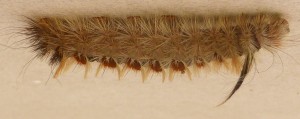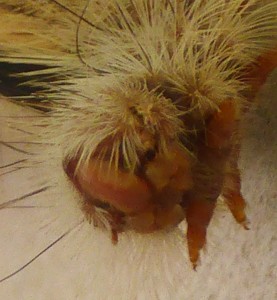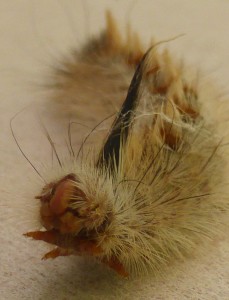Introducing a hairy caterpillar bringing attention to itself by crawling over the ceiling on a warm late winter day: Trichiocercus sparshalli, the caterpillar of Sparshall’s Moth .
 Sparshall’s Moth Caterpillar is distinctive with its black spike of hair, hairy yellow strip of tufts down its back and brown furry body. But is is a clear match for the reference one at the Atlas of Living Australia.
Sparshall’s Moth Caterpillar is distinctive with its black spike of hair, hairy yellow strip of tufts down its back and brown furry body. But is is a clear match for the reference one at the Atlas of Living Australia.
 All photos I have seen on the web show the spike going forwards – but this hanging caterpillar in a strong wind, definitely has a spike going backwards!
All photos I have seen on the web show the spike going forwards – but this hanging caterpillar in a strong wind, definitely has a spike going backwards!
How on earth does he hang on upside down? Look at those tiny feet (photo right)? Even more remarkable when you half- turn the photo and realise it’s his prolegs holding his body on, not his legs (photo below right).
Why is he on a barren ceiling? Well, given that their food is reported by the Butterfly House to be leaves of the Myrtle family (Myrtaceae) and that Eucalypts are a part of this plant family, it looks like he must have been blown off the Yellow Gum adjacent to the verandah! I hope he found his way back!
 And what might be eating it in the tree? Yes, we do have native birds here! And presumably parasites that consume them.
And what might be eating it in the tree? Yes, we do have native birds here! And presumably parasites that consume them.
So that makes this caterpillar of Sparshall’s Moth a welcome visitor in our farm garden and biodiversity …. I hope he made it back to the tree!
I will have to keep a watch on the insects coming to the house lights now to see if there is an adult Sparshall’s Moth here!
The Butterfly House notes that there are two Australian races of Sparshall’s Moth based on the colours of the tufts down the back of its caterpillars:
* east coast = white to yellow body, red strip of tufts and hard to see tuft on the head.
* west coast = yellow strip of tufts. … interesting , as we are closer to the east than the west coast. But the Great Dividing Range separates us from the east coast.
Apparently these caterpillars group together when young, but may go off on their own later on- like this one. Perhaps that it to give them a better chance to reach adulthood, as the Butterfly House also notes that they are often preyed upon by parasites. This was the case with the one on the Brisbane Insects page, which also looks like mine.
return to the Biodiversity on our farm main page
page set up 3 Sept 2016
